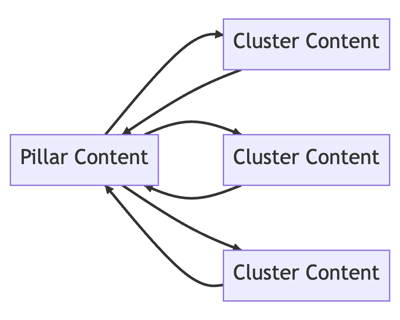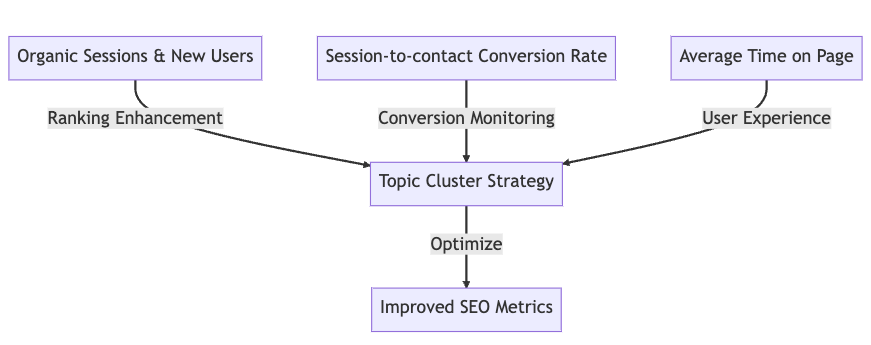How to Master HubSpot’s Topic Cluster Tool
In order to educate and nurture prospects through the buyer’s journey, your content needs to somehow get in front of them. Organic search can provide a great opportunity for you to reach audiences who are searching for information relevant to your company.
But, search listing results pages are getting more and more competitive, making it hard to be found online. It turns out there’s an effective solution: a topic cluster strategy, which can be simplified by HubSpot’s topic cluster tool.
What is a Topic Cluster?

A topic cluster, at its core, is an organic search technique. Topic clusters group multiple pieces of content, typically blogs and gated assets, under a shared theme, aiding in your website’s topical authority and improving the rank for relevant keywords.
Topic clusters consist of a primary keyword known as the “core topic” and then various related, more specific keywords referred to as “subtopics.” Topic clusters hinge on the creation of a 'pillar' page.
A pillar page serves as the main hub for a specific topic, and multiple related, but more specific, content pieces – or 'cluster' content – link back to this hub. This approach mirrors the way users search and consume content online and is valued by search engines. The inclusion of a pillar page is what differentiates a topic cluster strategy from just internal linking.
How to Quickly Build Out a Topic Cluster
1. Identify your Pillar Content: Begin by identifying the broad topics that are closely aligned with your business goals and your audience's interests. These broad topics will serve as your pillar content.
2. Develop your Cluster Content: Next, develop your cluster content. These are specific, related subtopics that support your pillar content. Each piece of cluster content should provide distinct value and comprehensively cover a specific aspect of the main topic.
3. Implement Hyperlinking Structure: Link each piece of cluster content back to your pillar page. This establishes a strong interlinking structure that improves site architecture, boosts SEO, and improves user navigation.
4. Monitor and Adjust your Strategy: HubSpot's Topic Cluster tool allows you to monitor the performance of your topic clusters. This data enables you to make informed decisions, optimize your content, and ensure your strategy aligns with your audience's interests.
HubSpot SEO Tools: Topic Clusters
HubSpot’s topic cluster tool allows you to identify and analyze potential core topics by providing information like monthly search volume and difficulty. This tool simplifies the process of creating and managing topic clusters by visualizing and organizing your content strategy.
Once you decide to move forward with a core topic, the tool will help you visualize how your topic cluster is implemented on your website. Your core topic and respective pillar page will be in the center of your bubble map — spanning from it are all the related keywords you have (or plan to have) support content. With the HubSpot Topic Cluster Tool, you can:
- Monitor the search volume of all keywords included in your strategy
- See what queries are leading visitors to your pillar page and subtopic content
- Ensure all your topic cluster assets are linked together
-1.webp?width=800&height=518&name=Creating%20a%20Content%20Marketing%20Strategy%20in%20HubSpot%20Implementation%2c%20Part%202%20(3%20of%206)-1.webp)
How to Use HubSpot's Topic Cluster Tool
However, when using HubSpot’s topic cluster tool, it is important to keep in mind that it’s just a tool. It’s more of an organizational assistant than it is like a tactical implementor. Your strategy is what actually makes topic clusters beneficial for SEO.
So in addition to using the topic cluster tool to envision your efforts and report on their performance, you should also be employing tactics like editorial calendars, SEO copywriting and internal linking.
Selecting Core Topics
Your core topics should be central to your business and your service operations. For example, a core topic for us at New Breed is “What is Demand Generation?”
Additionally, the core topics you choose should be top of the funnel because you’re targeting people who want to learn about that topic. You wouldn’t want to use something like “demand generation services.”
You also want to ensure that your core topic has enough search volume to justify the investment into creating a topic cluster around it. We recommend a minimum of 400 searches per month, but you also want to make sure the search volume isn’t so high that you couldn’t realistically rank for it.
Mapping Out Subtopics
Once you’ve selected your core topic, the next step is to explore related terms to use as subtopics. These subtopics don’t all need to include the core topic keyword, either. For “What is demand generation?” pillar topic, potential subtopics could include:
- “demand generation best practices”
- “how to implement a demand generation strategy”
- “demand generation tactics”
- “full-funnel marketing and sales strategies”
- “data-driven marketing”
HubSpot’s topic cluster tool can help you refine your subtopic keywords once you have an initial idea of what you want to use. As you go to add a subtopic keyword to your cluster, it’ll show you the search volume for that keyword and provide a list of related keywords you could use instead.
Your topic cluster should have a minimum of six subtopics to start, but eight to 10 is the ideal range. If you find that you need many more subtopics than that to cover the core topic fully, it might be worth splitting it up. For example, “What is inbound marketing?” and “Inbound marketing best practices” could both be their own pillar pages with 10 or more subtopics.
Creating and Publishing Content
Prior to launching a topic cluster within the HubSpot tool, you should have the majority of the content already prepared.
Create an editorial calendar to guide the creation of your pillar page and subtopic blog posts. Research, write and optimize all the content, then publish it and link everything in the tool.
The HubSpot topic cluster tool will help you ensure you created content to address every planned subtopic and placed hyperlinks within the copy for all posts. Plus, if you want to expand your topic cluster further, it can help you see what you haven’t covered yet and if you have relevant existing content on your website that could be optimized and linked to the pillar page.
SEO Metrics to Measure Your Content Performance
The goal of a topic cluster strategy is to increase your ability to rank for the core topic. So, an increase in sessions will be one of the most influential metrics for you to monitor. You’ll want to keep an eye on session-to-contact conversion rate, but since this is a top-of-the-funnel strategy, organic sessions and new users will be priority KPIs initially. You shouldn’t necessarily expect a lot of on-page conversions.

Another significant metric to track is average time on page because it’s a user experience metric that is a big indicator to search algorithms about the value your content is providing. When it comes to evaluating the performance of your topic cluster strategy, there are a few key SEO metrics to keep an eye on:
- Organic sessions and new users: As the primary goal of a topic cluster strategy is to enhance your ranking for the core topic, an increase in sessions will be one of the most essential metrics to monitor.
- Session-to-contact conversion rate: While this is a top-of-the-funnel strategy, and you shouldn't necessarily expect a lot of on-page conversions, keeping track of this metric can help you understand how effectively your content is driving conversions.
- Average time on page: This user experience metric can give you insights into the value your content is providing to users. A high average time on page can be a strong signal to search algorithms about the quality and relevance of your content.
The Takeaway
A topic cluster strategy helps you efficiently create topical authority for organic search. Content is still king; you need well-written, valuable content to see success from this strategy. But once you have that, a topic cluster can help you harness its full potential and ensure it’s visible for search engines and readers.
HubSpot’s topic cluster tool enables you to more easily manage and monitor your topic cluster strategy. It’ll not just help you ensure your strategy is implemented correctly initially, it’ll also help you monitor and expand your topic clusters over time, so you can create content that provides the most value for your audience and your business.
Rider Gordon
Rider Gordon is the Demand Generation Manager at New Breed. In his free time, he likes to ski, fly fish, and brew beer.





